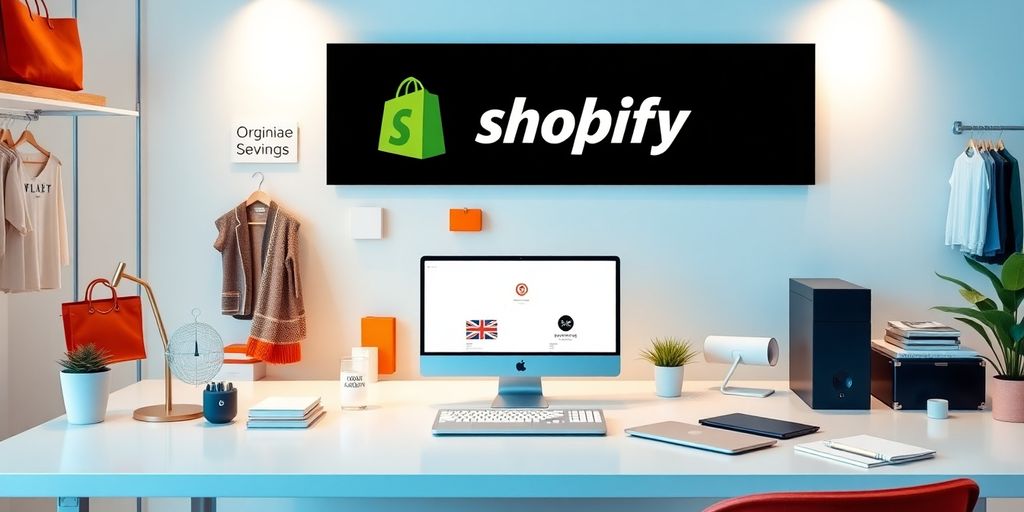Thinking about jumping into Shopify dropshipping? It's a big world out there, but don't worry, we've got you covered. This guide will walk you through everything you need to know to make your dropshipping business a success in 2025. From setting up your store to finding the right products and marketing them effectively, we'll break it all down. Let's get started and turn your e-commerce dreams into reality.
Key Takeaways
- Shopify is a top choice for dropshipping due to its user-friendly platform and strong support system.
- Choosing the right products and suppliers is crucial for success in dropshipping.
- Effective marketing strategies like social media and email marketing can boost your store's visibility and sales.
- Automation tools can help streamline operations, making your business more efficient.
- Understanding legal and financial aspects is important to avoid any roadblocks in your dropshipping journey.
Understanding the Basics of Dropship for Shopify
What is Dropshipping and How Does it Work?
Dropshipping is a retail fulfillment method where you don't keep the products you sell in stock. Instead, when you sell a product, you purchase the item from a third party and have it shipped directly to the customer. As a result, you never see or handle the product. This model is attractive because it requires less capital to start your business. You don't have to invest in inventory upfront, which reduces financial risk.
Here's how it typically works:
- You set up an online store and list products for sale.
- When a customer places an order, you purchase the item from a supplier.
- The supplier ships the product directly to your customer.
This means you act as a middleman between the customer and the supplier, focusing on marketing and customer service while leaving inventory and shipping to others.
Why Choose Shopify for Your Dropshipping Business?
Shopify is a popular choice for dropshipping because it offers a simple and user-friendly platform to build your online store. With Shopify, you can easily customize your store's look and feel without needing any coding skills. It also provides a range of tools to help you manage your business effectively, from processing payments to tracking orders.
Some reasons to choose Shopify include:
- Ease of Use: It's designed for beginners, so you can get your store up and running quickly.
- Customization Options: Choose from a variety of themes and apps to tailor your store to your brand.
- Integrated Payment Solutions: Accept payments from major credit cards and other payment methods seamlessly.
Key Benefits of Dropshipping on Shopify
- Low Startup Costs: You don't need to invest heavily in inventory, making it a cost-effective way to start an online business.
- Flexibility: You can run your business from anywhere with an internet connection, giving you the freedom to work on your own terms.
- Scalability: As your business grows, you can easily expand your product range or market reach without the complexities of traditional retail.
Running a dropshipping business on Shopify lets you focus on what matters most—building your brand and connecting with customers. With the technical side taken care of, you can spend more time on marketing and growing your store. Explore three simple methods to begin dropshipping on Shopify and start your entrepreneurial journey today.
Setting Up Your Shopify Dropshipping Store

Choosing the Right Shopify Plan for Your Needs
So, you're ready to kick off your dropshipping adventure on Shopify? Great choice! But first things first, you've got to pick the right Shopify plan. Shopify offers a variety of plans, from Basic to Advanced, each catering to different business needs. If you're just starting out, the Basic plan might be all you need. It's affordable and covers the essentials. But, if you plan to scale quickly, consider the Advanced plan for its robust features. Remember, the plan you choose should align with your business goals and budget.
Designing Your Store: Themes and Customization
Once you've settled on a plan, it's time to make your store look amazing. Shopify has a ton of themes to choose from, both free and paid. Pick one that resonates with your brand's vibe. Customization is key here. You can tweak colors, fonts, and layouts to fit your style. Don't forget to make it mobile-friendly since a lot of folks shop on their phones these days. A well-designed store not only attracts customers but also keeps them coming back.
Essential Shopify Apps for Dropshipping Success
Now, let's talk about apps. Shopify's App Store is like a treasure trove for dropshippers. You'll find apps for everything from product sourcing to customer service. Here are a few must-haves:
- Oberlo: For finding and importing products directly into your store.
- AutoDS: Helps automate order fulfillment and keeps track of your inventory.
- Klaviyo: Perfect for email marketing to keep your customers engaged.
Setting up your Shopify dropshipping store might seem overwhelming at first, but with the right tools and a bit of creativity, you can create a store that's not only functional but also a true reflection of your brand. Take it step by step, and soon enough, you'll be ready to start a dropshipping business on Shopify with confidence.
Finding and Sourcing Products for Your Shopify Store
Conducting Effective Product Research
Alright, let's talk about the heart of your dropshipping store—products. You can't just throw any random item on your Shopify store and expect it to sell like hotcakes. Nope, it takes some digging to find those gems that customers actually want to buy. Effective product research is your best friend here. Start by exploring trending products on platforms like AliExpress and Amazon. Look at the number of orders, ratings, and reviews to gauge demand. You can also use tools like Sell The Trend to streamline this process. It pulls data from various platforms, helping you spot hot items with ease.
Top Tools for Finding Winning Products
When it comes to finding products that will fly off the virtual shelves, having the right tools can make all the difference. Tools like AutoDS and Sell The Trend are game-changers. AutoDS offers a winning product section, giving you insights into high-profit items. Plus, it shows you FB ad engagements and target audiences, which is super handy. Sell The Trend, on the other hand, lets you import products directly from AliExpress with just a click. It's like having a personal assistant for your product research.
Working with Reliable Suppliers
Once you've nailed down what to sell, you need to find someone to supply it. This can be tricky, but it's crucial to work with reliable suppliers to keep your customers happy. Look for suppliers with good reviews and reasonable shipping times. You don't want your customers waiting forever for their orders. Consider both domestic and international options, and weigh the pros and cons of each. Domestic suppliers might offer faster shipping, but international ones could have better prices. It's all about finding the right balance.
Remember, your product choices and suppliers are the backbone of your dropshipping business. Take the time to get them right, and you'll set yourself up for success.
Marketing Strategies to Boost Your Shopify Dropshipping Business
Leveraging Social Media for Brand Awareness
Social media is your best friend when it comes to getting your Shopify dropshipping store noticed. Pick platforms where your target audience hangs out the most—be it Instagram, TikTok, or Facebook. Share content that’s not just promotional but also engaging and informative. Highlight how your products solve real problems and use hashtags to expand your reach. You can also run contests or giveaways to increase engagement and attract new followers.
Email Marketing: Building and Nurturing Your Audience
Email marketing is like that trusty old friend who never lets you down. Start by collecting emails through sign-up forms on your website. Once you've got a list, segment it based on customer behavior and interests. Send out newsletters that keep your audience in the loop about new arrivals, special offers, and limited-time promotions to create a sense of urgency. Personalize your emails to make your customers feel valued and more connected to your brand.
Utilizing Paid Ads for Immediate Visibility
If you’ve got some budget to spare, paid ads can provide instant visibility for your Shopify store. Platforms like Google Ads, Facebook, and TikTok offer targeted advertising options that can help you reach specific demographics. The key is to test different ad formats and messages to see what resonates best with your audience. Paid ads can be a game-changer, especially when combined with organic strategies, to build a well-rounded marketing approach.
Consistency in your marketing efforts is key. Whether you’re going for organic reach or paid ads, the goal is to keep your brand in front of potential customers and make them remember you. Stay adaptable and keep testing new strategies to see what works best for your business.
Scaling Your Shopify Dropshipping Business

Automating Your Store for Efficiency
Alright, so you've got your Shopify store up and running. Now, it's time to think about automation. Automation is your best friend when it comes to scaling. It saves you time, reduces errors, and lets you focus on growth instead of mundane tasks. Tools like AutoDS can handle everything from product research to order fulfillment, making your life a whole lot easier. Imagine this: instead of manually updating inventory or processing orders, you can sit back and watch the magic happen.
Expanding Your Product Range with Multiple Suppliers
Next up, let’s talk about suppliers. Having just one supplier might seem convenient, but working with multiple suppliers is key to scaling your business. Why? Because it lets you offer a wider range of products. Plus, if one supplier runs out of stock, you’ve got backups. Use dropshipping apps to find reliable suppliers and fulfillment centers. This way, you can meet customer needs without breaking a sweat.
Enhancing Customer Experience for Better Retention
Customer experience is crucial. Happy customers mean repeat business and positive reviews. Here are some tips to keep your customers smiling:
- Use live chat to answer questions quickly.
- Have a detailed FAQ page.
- Handle returns and refunds promptly.
- Send personalized messages to show you care.
- Utilize customer support tools to streamline communication.
Remember, scaling your Shopify dropshipping business isn't just about increasing sales. It's about creating a seamless experience for your customers, so they keep coming back. When customers feel valued, they're more likely to stick around and even spread the word about your store.
By focusing on these strategies, you can take your Shopify dropshipping business to new heights. Whether it's through automation, expanding your product range, or enhancing customer service, each step brings you closer to a thriving business. So, roll up your sleeves and get started!
Overcoming Common Challenges in Shopify Dropshipping
Handling Customer Service and Returns
Alright, so let's talk about one of the less glamorous parts of running a Shopify dropshipping store—customer service and returns. It's no secret that dealing with returns can be a headache, but it's a crucial part of keeping your customers happy. A smooth return process can turn a frustrated customer into a loyal one. Here are some tips to keep things running smoothly:
- Clear Return Policies: Make sure your return policies are easy to find and understand. Nobody likes surprises when they're trying to return something.
- Prompt Responses: Respond to customer inquiries quickly. Whether it's a question about a product or a return request, fast communication can make a big difference.
- Use Automation Tools: Consider using apps that help automate customer service tasks, like responding to common questions or processing returns.
Remember, good customer service can set you apart from competitors and build long-term relationships with your customers.
Managing Inventory and Order Fulfillment
Inventory management can be a bit tricky when you're dropshipping since you don't hold the products yourself. But don't worry, there are ways to keep things under control:
- Reliable Suppliers: Work with suppliers who are known for their reliability. This means fewer headaches for you when it comes to stock levels and shipping times.
- Inventory Management Apps: Use apps that sync with your suppliers to keep track of stock levels. This way, you won't sell something that's out of stock.
- Regular Communication: Stay in touch with your suppliers regularly. This helps you stay updated on any potential issues that might affect your orders.
Staying Ahead of Market Trends
The e-commerce world is always changing, and keeping up with trends is vital. Here's how you can stay ahead:
- Market Research: Regularly research what's trending in your niche. Tools and platforms that analyze consumer behavior can be helpful here.
- Flexible Product Range: Be ready to adapt your product range based on what's hot. This might involve testing new products or dropping ones that aren't performing.
- Customer Feedback: Listen to what your customers are saying. Their feedback can give you insights into what they want and help you adjust your offerings accordingly.
By tackling these challenges head-on, you'll be better equipped to run a successful Shopify dropshipping business. Remember, it's all about being proactive and ready to adapt to whatever comes your way.
Legal and Financial Considerations for Shopify Dropshippers
Understanding Taxes and Legal Requirements
When you're running a dropshipping business in 2025, it's crucial to stay on top of legal requirements and taxes. First off, make sure your business is registered legally, as this will protect you from potential legal issues down the road.
- Business Registration: Depending on where you live, you might need to register your business as a sole proprietorship, LLC, or another type of entity.
- Sales Tax: Understand whether you need to charge sales tax to your customers and how to remit it to the appropriate authorities. This can vary widely depending on your location and where your customers are.
- Legal Policies: Shopify makes it easy to create essential store policies like refunds, privacy, and terms of service. Navigate to Settings > Policies in your Shopify dashboard to get started.
Always keep your business compliant with local laws to avoid any nasty surprises. It's not just about following rules; it's about building trust with your customers.
Setting Up Payment Gateways
A smooth checkout experience is key to keeping customers happy. Shopify Payments is a great option, supporting various payment methods like credit cards, Google Pay, and Apple Pay. But it's only available in certain regions, so you might need alternatives like PayPal, which is widely trusted.
- Diverse Payment Options: Offer multiple payment methods to cater to different customer preferences.
- Transaction Fees: Be aware of any fees associated with each payment gateway. These can add up and affect your profit margins.
- Security: Ensure that your payment gateways are secure and comply with industry standards to protect both your business and your customers.
Budgeting and Financial Planning for Growth
Running a successful Shopify dropshipping store isn't just about making sales; it's about managing your finances wisely. Start by setting a budget that covers your Shopify plan, marketing, and other operational costs.
- Plan Your Expenses: Know your fixed and variable costs, including Shopify subscriptions, apps, and marketing expenses.
- Monitor Cash Flow: Keep an eye on your cash flow to ensure you have enough to cover expenses and invest in growth opportunities.
- Profit Margins: Regularly review your product pricing and supplier costs to maintain healthy profit margins.
Remember, the goal is to scale your business sustainably. By keeping a close watch on your financials, you can make informed decisions and seize opportunities for growth.
When starting a dropshipping business on Shopify, it's important to think about the legal and money matters involved. You need to know about taxes, shipping rules, and how to protect your business. Make sure to check out our website for helpful tips and tools to guide you through these important steps!
Wrapping It Up: Your Path to Shopify Dropshipping Success
Alright, folks, there you have it! We've walked through the ins and outs of setting up a dropshipping store on Shopify, and hopefully, you're feeling a bit more ready to dive in. Remember, the key is to keep things simple and focus on what matters—finding those winning products and getting them in front of the right people. Sure, it might seem a bit overwhelming at first, but with the tools and tips we've covered, you're well on your way to building a store that not only runs smoothly but also makes you proud. So, roll up those sleeves, get creative with your marketing, and don't be afraid to tweak things as you go. Success in dropshipping is all about staying flexible and learning from each step. Now, go out there and make it happen!
Frequently Asked Questions
What is dropshipping?
Dropshipping is a way to sell stuff online without keeping it in stock. You just list products on your store, and when someone buys, you order it from a supplier who ships it to the customer.
Why use Shopify for dropshipping?
Shopify is easy to use and has lots of tools to help you run your dropshipping business smoothly. It’s popular because it makes selling online simple.
How do I start a Shopify dropshipping store?
First, sign up for Shopify. Then, pick a theme, add products from a supplier, and set up payment methods. You can start selling once your store looks good!
What are the benefits of dropshipping?
Dropshipping lets you start an online store without buying inventory upfront. It’s less risky and you can offer a wide range of products.
How do I find products to sell?
Use tools and apps to research popular products. Look for items that are trending or have good reviews, and find reliable suppliers to work with.
What if a customer wants to return a product?
Make sure to have a clear return policy. Work with your supplier to handle returns smoothly, and keep your customers happy.


